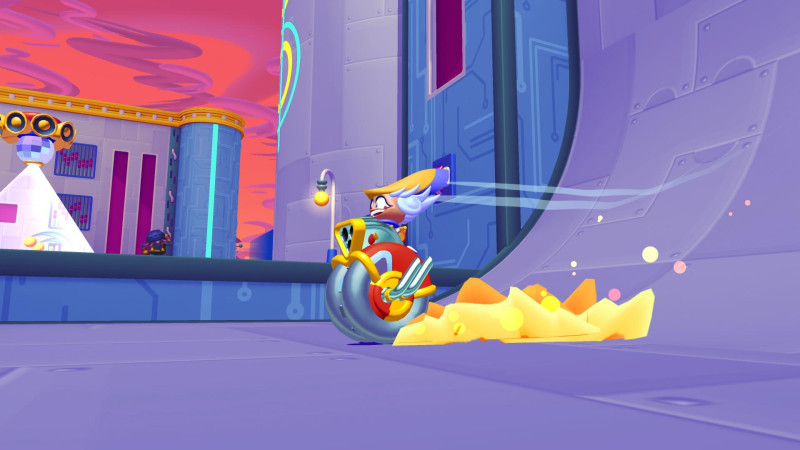
Coming off the success of Sonic Mania, the development team behind one of the best games in Sega’s storied series is back with an all-new franchise. Much like how the studio now known as Evening Star’s previous effort was a love letter to a bygone era of platforming, Penny’s Big Breakaway is a fond tribute to the 3D platformers of the late ‘90s. Evening Star clearly knows how to design a fantastic new entry in this well-worn genre, but some important issues drag down an otherwise strong game.
As Penny, a street performer whose yo-yo is transformed by a cosmic entity, you must leap, swing, spin, and dash through more than 11 colorful, themed worlds of stages. Each world is more colorful than the last, complemented by an upbeat soundtrack full of catchy tracks to push the action forward. In moving through these levels, Penny’s Big Breakaway steps into the spotlight in a big way. With the help of her enhanced yo-yo, Penny can pull off satisfying movement-based combos. Once you master the basics, jumping into the air, swinging from her yo-yo, landing in a roll, and smoothly launching into another combo with a twirl feels fantastic. In combat, however, I struggled with accidentally sending Penny flying off a cliff since double-tapping the attack button also initiates a dash.
[embedded content]
Thankfully, combat is only a small piece of the overall pie, and from the moment the movement mechanics clicked with me to the moment I watched the credits roll, I adored building momentum as I sped through the stages. Those terrific moves are accentuated by top-tier level design. Evening Star provides players with a ton of expertly designed courses that play into Penny’s abilities. Penny’s Big Breakaway is at its best when you’re moving quickly through obstacle courses, and the levels give you plenty of opportunities to do so; even the optional side objectives often require you to complete the given task within a time limit.
I relished every twisting path that let me quickly roll through, but I also enjoyed exploring every corner I could to find the collectibles used to purchase extra-challenging bonus stages. Levels typically offer branching pathways, and I loved trying to find the best route through the stages, though the fixed camera sometimes discouraged me from poking around too much. I was also disappointed by how many times I clipped through a stage element and had to restart from a checkpoint.
Sadly, the entire experience is brought down by a problem many early 3D platformers struggled with: depth perception. By the time I beat the story mode, I had lost count of the number of times I missed a seemingly easy jump because I couldn’t tell where Penny was in relation to the platform I was trying to land on. While the obvious answer is to look at her shadow’s position on the platform, my brain constantly needed to perform the calculus of whether Penny was where she looked like she was or where the game said she was. Unfortunately, this permeates the entire experience, poisoning the well of the overall gameplay.
A smaller issue that often rears its ugly head is that of screen-crowding. One of the key elements Penny’s Big Breakaway uses to propel the player forward is a group of penguins that swarm you in a capture attempt. Each time this happens, it immediately raises the level of on-screen chaos, but it sometimes goes too far as the penguins obscure everything happening in the level. Add to that an intrusive U.I. element that pops up when you’re near a side mission, and on multiple occasions, I had to blindly perform a leap of faith and hope for the best.
It’s a shame so many problems weigh on this otherwise enjoyable adventure. Even with the screen-crowding, bugs, and depth-perception troubles, I still look back fondly on the superb level design and movement mechanics. But because of those important detractors, Penny’s Big Breakaway lands as a solid 3D platformer unable to swing to the great heights it felt destined for.
